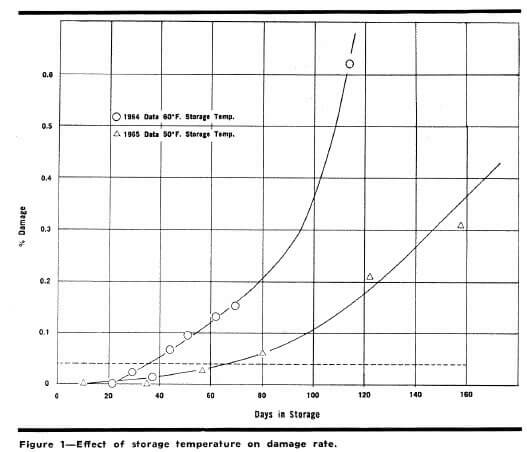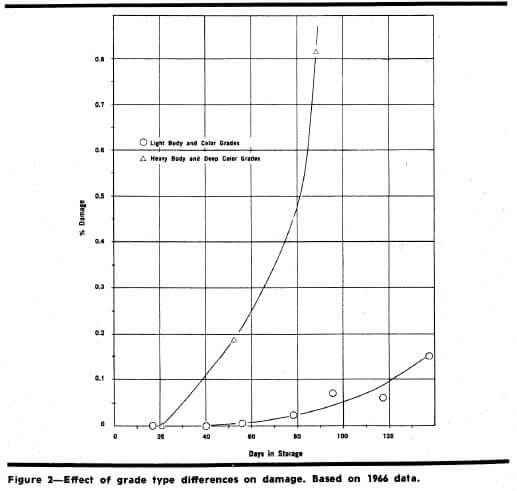The American Leaf Organization of the Imperial Tobacco Company of Great Britain and Ireland, purchases, processes and ships flue-cured tobacco to its parent company in Great Britain. The flue-cured marketing season runs from August through December during which time approximately one billion pounds of tobacco arc sold.
The tobacco marketing pattern in the United States creates a peak sales period lasting about six weeks during September and October, during which processors must purchase at a rate considerably in excess of their processing capacities in order to meet raw material requirements. In recent years, increasing purchases, combined with a shorter selling season and a reduction in suitable redrying facilities brought about by the increased use of threshing, have intensified this problem. Effects Of Storage: Tobacco as purchased can be stored for only a short period of time. The normal period between purchasing and processing is one to two weeks. Due to its high moisture content (18 to 20 percent) there is a constant danger of damage to the product in the form of fungal molds. Finding a method of extending the period during which unredried tobacco could be safely stored appeared a more logical alternative to enlarging threshing and redrying facilities that would be needed for only a short time each season. Experimental Method:  On the assumption that reduced temperature storage would retard the growth-of-the-flora responsible for mold on tobacco. Imperial began experiments along this line in 1963. The container in which unredried leaf tobacco arrives at the processing plants is a hogshead containing approximately 800 pounds of tobacco. If a hogshead was placed in a room refrigerated to the desired temperature (60° F in the initial work), heat transfer from the center of this mass to the air would take sufficiently long that damage might occur at the center before it had a chance to cool. For this reason, a method of quickly and uniformly cooling the entire contents of a hogshead was needed. Cooling by the rapid evaporation in a vacuum of some of the water on the tobacco appeared to be a practical approach. Initial experiments involving cooling in a small existing vacuum chamber and storage in an insulated room were promising to the point that, for the 1964 season, a special vacuum chamber for cooling was constructed and 40 thousand square feet of the Wilson, North Carolina Imperial plant were temporarily fitted with air conditioning equipment sized to maintain the area at 60° F against ambient heat load. Prior to the 1965 season, 90 thousand square feet of storage permanently equipped with air conditioning equipment capable of maintaining the temperature at 50° F were added to the plant. The target storage temperatures in both the initial work and the present installation were based on economic equipment and construction considerations. Storage temperatures below 50° would probably give a longer storage capability but would necessitate special building construction and provisions for air dehumidification. Equipment Utilized: The vacuum cooling units chosen for this initial installation consisted of two separate 6000-cubic-foot chambers and a two-part Croll Reynolds Chill-Vactor vacuum system utilizing steam jet ejectors. Each of the two chambers installed at Wilson is large enough to hold a tractor trailer unit loaded with thirty hogsheads of tobacco. The two part Croll Reynolds system, one for the removal of air from the chamber, and the other for evaporation of water, are alternated between the two chambers to give continuous cooling. This special arrangement results in a cooling production rate of approximately 24,000 pounds of tobacco per hour. The Process: The hogsheads arrive at the Wilson plant on flat bed trailers. Loads designated for cooling rather than immediate processing are taken to the cooler where the trailer is unhooked and the load cooled. When the process is completed the tractor is reconnected to the load and the tobacco is taken through the normal receiving process with the cool hogsheads placed in the air conditioned storage.
Use of the trailer-sized chambers is extremely convenient; but it necessitates more air removal than with a chamber designed for the hogsheads only. However, the elimination of the extra handling step more than pays for the increased size of the chamber. Leaf tobacco at the normal temperature and moisture content from the market will cool to approximately 40°F upon exposure to a pressure of 0.1 to 0.2 inches of mercury absolute for one hour. Flue-cured tobacco has a heat capacity of approximately 0.5 BTU/ pound °F and is normally received at 75 to 80°F, necessitating the removal of approximately 1.5 percent moisture or approximately 400 pounds of water from a 30-hogshead load.
The three stage ejector system was designed to handle 450 pounds per hour of water vapor at 0.15 inches of mercury absolute. Tobacco Behavior: The rate of damage versus the length of time in storage at temperatures of 50°F and 60°F on the same grade of tobacco is illustrated in the plot in Figure 1. The horizontal dotted line indicates the normal damage level of uncooled tobacco in this grade at the time of processing. Different grades of tobacco behave quite differently when stored using the vacuum cooling and subsequent cold storage methods. The differences are not necessarily a function of differences in initial moisture contents. It has been the experience of the company that just as in the case of storing without cooling, the grades characterized by thin to medium body and light color keep much better than those characterized by heavy body and dark color. This is illustrated in a time plot of the damage rate in storage for these two grades (Figure 2) . Since the initial installation in 1964, over 35 million pounds of tobacco have been vacuum cooled and stored by the company. The vacuum cooling method and subsequent storing at 50°F has allowed the company to extend the safekeeping period of flue-cured unredried light bodied tobacco from one or two weeks to twelve weeks and for the heavier grades to a safekeeping period of five weeks. Under present circumstances, there is little doubt that the vacuum cooling process is a logical solution to Imperial’s Wilson, North Carolina, tobacco storage problem. By: S.E. Stout – Research & Technical Department, The Imperial Tobacco Company (of Great Britain & Ireland), Limited Wilson, N.C.



